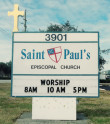'My Lord and My God'
Text: John 20:1-18

Sunday Sermon
The Rev. Dr. D. William Faupel
Priest-in-Charge
Apr. 1, 2018
Christ is Risen, Alleluia
Introduction
Did you ever observe that the Gospel of John, which you just heard read this morning, never tells us that Jesus rose from the dead? No, I am not telling you a bad April’s fool joke, this first day of April. In Matthew, Mark, and Luke when the women come to the tomb they are encountered by angles who state flat out: “He is not here, He is risen.” But not John. Instead he tells us what some of Jesus closest friends thought and felt, and how they came to believe that Jesus was not dead but alive.
He begins his story by telling us that it was still dark. We know that he uses symbolic language throughout his gospel – telling us that Jesus is the bread of life, the living water, the vine and we are the branches. Here he is letting us know darkness covers the minds of his friends. No one is expecting the Resurrection. But as the story moves along, the sun begins to rise. Half way through today’s gospel, the disciple Jesus loved, saw and believed. And at the end, it is Mary who came from the little village of Magdala on the coast of the sea of Galilee who declares: “I have seen the Lord.”
In taking this approach, telling us how his friends came to believe that Jesus was alive, John hopes as he tells us later in the same chapter, that we will come to the same faith, and even more, that we will come to believe “that Jesus is the Messiah, the Son of God, and that by believing we will have life through his name.” (John 20:31)
The gospel falls into two parts, the first tells us about Peter and “the other disciple” who is never named, but most scholars think was John, the writer himself. The second tells us about Mary. Each half confronts us with these people and their responses to Jesus. In reading about their response, we confront ourselves as well.
I. The Discovery
First, then let’s pay a little more attention to the three who come to the tomb just before the break of day on that Sunday morning.
A, We see how the story gradually unfolds allowing us, the readers, to look over the shoulders of these three persons to see what is happening and, with them discover the meaning of what they are seeing.
On the last words before our gospel reading opens we have learned that Jesus’ body had been placed in a tomb, hewn out of a rock on the side of a hill. It’s not below ground like most of our graves are today, but more like a cave. Inside the cave sits a long flat bench on which the body would be placed. Unlike our graves today, the body was not intended to remain here until the end of time. Rather it would normally be kept there for a year or so until the body decomposed and only the skeleton remained. Then the bones would be detached and placed in a wooden box, called an ossuary, and placed in another larger cave with other sets of human remains functioning much like a columbarium where we place ashes today. Outside the cave a six-inch deep trough would be cut across the mouth of the tomb and extending beyond for several feet. In the trough a huge wheel-like stone would be placed. Once the body was placed on the bench, the stone would be rolled across the mouth, sealing the entrance.
We then come to the beginning of our reading. Its early Sunday morning and a sequence of four discoveries take place.
First, Mary discovers that the stone has been removed from the mouth of the tomb. It’s still dark but in the twilight, she doesn’t go any closer. She has seen enough to reach some conclusions. She leaves immediately and runs to tell Peter and John: “They have taken the Lord out of the tomb and we don’t know where they have laid him.”
Second, Peter and John are shocked by this news and run to the tomb to see for themselves. Peter is a bit older than John and slightly out of shape. So, John gets to the tomb first. Sure enough, he finds the stone rolled away and the mouth of the grave open. He stays outside, but bends down and looks in. The body is not lying on the bench and is nowhere else in the cave. What he does see are the linen cloths in which the body has been wrapped are scattered on the floor.
Third, Peter finally arrives, huffing and puffing. He doesn’t take time to catch his breath, but walks bent down and immediate goes into the tomb. He too saw the body was gone and the linen wrapping on the floor. But he also noticed the linens that had wrapped our Lord’s head had been folded neatly on the bench.
Finally, John also went into the tomb. He saw and believed.
B, We have already been told what John saw when he was outside looking in. But now that he was in what was it that he believed? And on what basis did he come to this conclusion? He believed that Jesus had been raised from the dead. He came to this conclusion for two reasons.
Frist, he believed what his eyes saw. The stone was rolled away, the grave cloths were scattered on the ground and the body was missing. It took a minute for this to sink in but then it clicked. Mary has seen the stone rolled away and concluded that the body had been stolen, probably by some of Jesus’ enemies.
John comes to a difference conclusion. To him Mary’s theory didn’t make sense. To be fair, Mary didn’t have all the evidence that John had. He saw the grave cloths. If someone had abducted the body, would they have taken the time to unwrap it? Surely, they would have wanted to get in and out as quickly as possible before they were caught. Besides the corpse would have been much easier to carry when it was tightly wrapped. And wouldn’t they have resealed to tomb hoping the theft would not soon be discovered? John would have made a good homicide detective.
More important, however, as he considered the evidence before him, Jesus' words undoubtedly came flooding back. At least three times Jesus had told his disciples, “The Son of Man must suffer and die and after three days rise from the dead. At the time when they had heard Jesus speak, it did not make any sense. They had been in denial. In fact, on one occasion Peter had rebuked Jesus for that kind of thinking, and Jesus had called him Satan for temping him. But now, standing in the cave, the word made sense. Jesus was alive. His prediction had come true. John saw and believed.
II. The Recognition
To our surprise, having made this discovery, Peter and John go home. Typical response for two men, don’t you think. Jesus is ok after all. We don’t have to worry about him anymore. We can get on with our lives. Maybe we will go back to fishing.
And so, Mary reenters the picture. Not only was she the first to discover that Jesus was missing, but she is the first person to talk to Jesus From the other Gospels we know that Mary is one of a number of women who followed Jesus. Luke tells us that Jesus had healed her by casting out seven demons. Undoubtedly, she had been healed from an abusive life. Her gratitude and devotion to Jesus knew no bounds.
At this point we are not told that she had talked with Peter and John after they made their discovery, nor are we told that she looked into the tomb. She simply returns, standing outside the tomb silently weeping as she mourns the one who had done so much for her.
Finally, she gathers up the courage to look inside. It is not the grave cloths that she sees, but two visitors from another world where God rules and his servants walk in white. The angles asker her: “Woman, why are you weeping?” She replies for a second time: “they have taken away my Lord.”
Then she hears a voice behind her asking the same question: Woman, why are you weeping?” Turning she saw a man she mistook for the gardener. Thinking that he might have party to Jesus' disappearance, she implores: “Sir, if you have carried him away, tell me where.”
Jesus, calls her by her name, “Mary.” Recognition dawns. Clutching his arm, she cries out in joy, “My Lord!” Unlike Peter and John, Mary then shares this wonderful news to all her friends. Do you think Mary doesn’t know how to love Him? (as she sang in Jesus Christ Superstar). Go, read this gospel again!
III. The Response
You and I do not have the privilege of discovering that Jesus is alive by clutching his arm as Mary did in the garden, or by placing our finger in the nail print in his hand as our Lord invited Thomas to do in the Upper Room. But I think John was on to something when he invited us to look over his shoulder, and the others as they came to faith through the encounter with the living Christ. For down through the centuries, men and women as they have heard John’s story have come to the same faith and they heard the voice within them, call them each by name. It is my prayer this morning that as we hear that inner voice calling each of us, we will respond as Mary did by saying: “My Lord and My God.”
SUPPORT ST. PAUL'S DONATE NOW OR RECURRING DONATION

3901 Davis Blvd., Naples, Florida 34104 239-643-0197 Office hours 9 a.m. to 1 p.m. Monday-Friday


